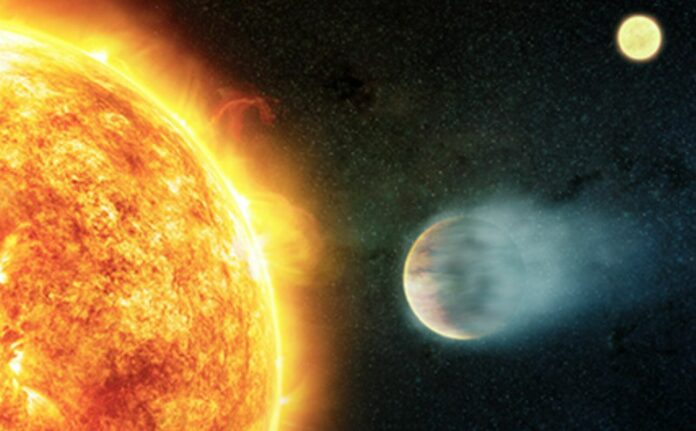Observations of binary systems verified the hypothesis of hot Jupiters rejuvenating their host stars. They rotate more quickly and exhibit high activity, which is a trait of young luminaries when a nearby, large planet is present.
Hot Jupiters are exoplanets with masses equivalent to Jupiter, although they are much closer to their stars than Mercury is to the Sun. As a result, they are incredibly hot: even iron evaporates on such worlds. A hot Jupiter, on the other hand, can have a “rejuvenating” influence on stars. Scientists from the Potsdam Astrophysical Institute (AIP) described these conclusions in an article published in the journal MNRAS.
The fact that “hot Jupiters” (gas giant exoplanets that orbit a star at Mercury’s distance or closer) don’t age has been seen before, but this result is the first time it has been documented in a systematic way. This is the strongest test yet of this strange phenomenon.
“In medicine, you need a lot of patients enrolled in a study to know if the effects are real or some sort of outlier,” adds lead author Nikoleta Ilic.
“The same can be true in astronomy, and this study gives us the confidence that these hot Jupiters are really making the stars they orbit act younger than they are.”
By exerting tidal pressures, a hot Jupiter may cause its host star to spin more swiftly than it would without the planet. As a result of its faster rotation, the host star may become more active and emit more X-rays, which are often characteristics of a young star.
But much like with people, a star’s vitality depends on a variety of things. As they get older, all stars will slow down their rotation and activity, and they will have less outbursts. Since it is hard to know exactly how old most stars are, it has been hard for astronomers to tell if a star is unusually active because it is being affected by a nearby planet, which makes it act younger than it really is, or if it is young.
Ilic’s latest Chandra study focused on double-star (or “binary”) systems, where only one of the stars has a hot Jupiter orbiting it and the stars are considerably separated from one another. The stars in binary systems all develop at the same moment, just like human twins, according to astronomers. The distance between the stars is far too great for them to interact or for the hot Jupiter to have any impact on the other star. This indicates that they may utilize the system’s star devoid of planets as a control.
“It’s almost like using twins in a study where one twin lives in a completely different neighborhood that affects their health,” explains co-author Katja Poppenhaeger. “By comparing one star with a nearby planet to its twin without one, we can study the differences in behavior of the same-aged stars.”
How “young” a star is acting was determined by the researchers using the quantity of X-rays. They studied nearly thirty systems in X-rays, looking for signs of planet-to-star interaction (the final sample included 10 systems viewed by Chandra and six by ESA’s XMM-Newton, with several observed by both). They discovered that stars with hot Jupiters tended to be more active than their partner stars without hot Jupiters because they were brighter in X-rays.
“In previous cases there were some very intriguing hints, but now we finally have statistical evidence that some planets are indeed influencing their stars and keeping them acting young,” adds co-author Marzieh Hosseini. “Hopefully, future studies will help to uncover more systems to better understand this effect.”
